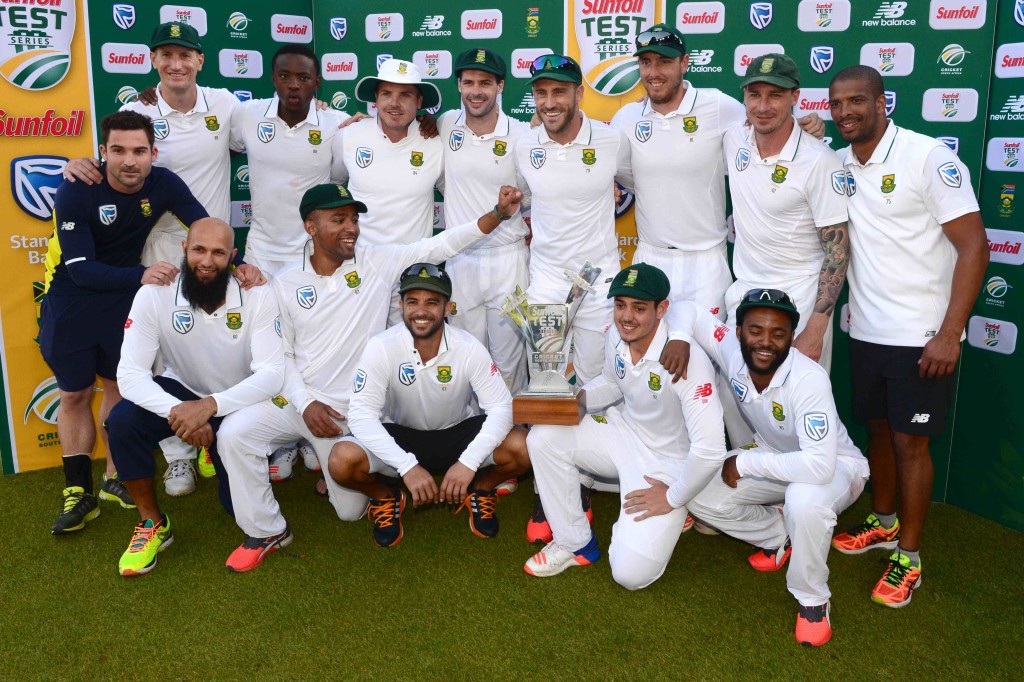Four SAcricketmag.com writers’ views on the news there will be at least two Black Africans and six players of colour in the starting XI.
Gary Lemke
Undesirable in the eyes of many it might be, but there should be little disruption to the performances of the Proteas with the new targets. The recent Test win against New Zealand at Centurion, described by Faf du Plessis as a ‘near perfect’ performance, was achieved with Kagiso Rabada, Temba Bavuma, JP Duminy, Vernon Philander, Dane Piedt and Hashim Amla in the XI. Under the new ‘dispensation’ that would tick the minimum requirements, the side wasn’t weakened and when AB de Villiers returns it should be at the expense of Stiaan van Zyl.
In reality, the selectors have a season to meet those targets. Some matches, in the Tests should Rabada or Bavuma be unavailable for instance, might not have six players of colour in the XI – but in others, namely T20s and ODI, they might well have more than six. In a game of numbers, these will be manipulated.
Give it a couple of months … my opinion is that the more things change, the more they will have stayed the same. There’s no reason why the Proteas won’t please the politicians and the public and then the country can finally move on from all the negative connotations around the word ‘transformation’.
Tom Sizeland
Not much changes. It merely confirms and sets in stone what’s already happening. What now and will become increasingly unclear, however, is whether all of the players are and will be there on merit.
What if, hypothetically, Kagiso Rabada or Temba Bavuma got injured for the rest of the Test season? Is there a black African player waiting in the wings to step up? Whoever that player is, what does it do to a player who knows that they wouldn’t have been picked if the targets weren’t put in place? It’s an aggressive stance that doesn’t quite match up to the resources available.
The targets need to be met across the three formats, which means the potential loss of Rabada and Bavuma to the Test side could be made up in, for example, the ODIs. The ODIs, the ‘in-between’ and increasingly unwanted format of the game, could be used to throw a handful of players of colour in the deep end, and by doing so, bring up the transformation percentages. This is a manipulated and controversial situation waiting to happen.
Perhaps the decision was out of CSA’s hands anyway. To what extent has Minister of Sport Fikile Mbalula had a say in the matter? He threatened to close off CSA and SARU from hosting major tournaments. At least now this paves the way for the hosting of the World T20 in 2018. The transformation targets are all but met anyway. Confirmed figures are now in place.
Khalid Mohidin
The issue around transformation acts as a brilliant opportunity for young stars, who happen to be of colour, to move up into the Proteas side. Jason Smith, Zubayr Hamza and Andile Phehlukwayo could all creep into the national side faster than they would’ve expected. They’re on the radar already, so are these targets necessary when South Africa is already producing many stars of colour naturally? Our national team already boasts six players falling into the bracket of the new transformation target.
The new transformation laws put selectors in an incredibly sticky situation. If the transformation targets were implemented on grassroots level as well as First-Class domestic level, those who have less opportunities will find themselves in a more comfortable position for exposure. This could help us build a strong pool of players for our national selectors making it easier for them to select a side based on merit. By nurturing cricketers from a young age, more up-and-coming talent of colour will receive equal opportunities.
I strongly believe that being picked on merit should be the driving factor for our selectors in the future. Moving forward, I ask the question, is it possible to be world leaders and still meet the new transformation targets?
Mark Salter
If, as the president of CSA, Chris Nenzani, proudly claims, the Proteas have already met or exceeded the proposed quotas, the question arises as to why they are to be imposed.
Is it because they do not trust the convenor of selectors, Linda Zondi, and his panel to do the right thing within ‘guidelines’? That they might just pick the best available team, regardless of colour?
The executives have nonetheless given them great flexibility by aiming for an average across all formats, but you can be sure that there would justifiably be an outcry if they picked an excessive number of black players in, say, a dead rubber match at the end of the season, which would help meet the average target.
It would be good to hear what black players themselves think of these quotas. It has been 10 months since a group called Black Players in Unity aired grievances about game time, and a full six months since the chairman of the transformation committee, Norman Arendse, was appointed to look into the matter. Silence reigns supreme. At the time, it was unclear whether the players were saying that, if picked, they must play, or whether they would prefer not to be part of a token system.
The inclusivity of the game will not come by adding more players of colour to the national team; it will come from more resources being allocated to underfunded and deprived areas, providing facilities, equipment, support staff; by getting more struggling schools and clubs across the country involved. Perhaps, instead of throwing costly junkets, the Minister of Sport and CSA could dedicate themselves to increasing the pool of players. With all respect, the Rabadas are already in the pipeline; it’s the Ntinis they have to go and find.
Photo: Lee Warren/Gallo Images







